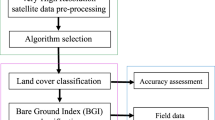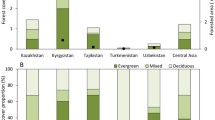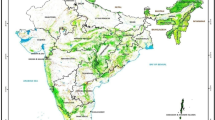Abstract
Accurate forest assessment is essential to detect and tackle deforestation, especially in emerging economies. In Colombia, three different geo-spatial data sources are available for forest monitoring: the European Space Agency (ESA), the Institute for Hydrology, Meteorology and Environmental Studies (IDEAM), and the Global Forest Change Data (GFCD) from the University of Maryland. These information sources have distinct characteristics, purposes, and coverage, and their peculiarities can lead to marked differences in the results when they are used to produce forest cover maps. In this study, we determine the optimal forest threshold for GFCD and assess the accuracy of the three data sources in map** forests, on the basis of a stratified sample of sites, with Colombian ecoregions used as strata. At each site, the classification into forest or non-forest, according to one of the sources, is compared with reference data collected through Google Earth imagery and landscape photographs. Accuracy measures are produced at both the ecoregion and national level. IDEAM and GFCD prove to be quite accurate in most cases, and each of them turns out to be the best forest map in about half of the ecoregions. GFCD’s optimal threshold is found to be equal to 90% in almost all those ecoregions for which it represents the best performing data set.









Similar content being viewed by others
Notes
The Climate Change Initiative’s Land Cover data set is generally referred to as CCI-LC.
The GFCD database can be downloaded at https://glad.earthengine.app/view/global-forest-change.
The ESA database can be downloaded at http://maps.elie.ucl.ac.be/CCI/viewer/download.php.
The IDEAM database can be downloaded at http://visor.ideam.gov.co/geovisor.
The error of commission is calculated as the number of observations incorrectly classified in a given class, divided by the total number of observations classified in that class.
The error of omission is calculated as the number of observations belonging to a given class but classified in a different class, divided by the total number of observations belonging to that given class.
See information at http://smbyc.ideam.gov.co/MonitoreoBC-WEB/reg/indexLogOn.jsp.
References
Armenteras D, Cabrera E, Rodríguez N, Retana J (2013) National and regional determinants of tropical deforestation in Colombia. Reg Environ Change 13:1181–1193
Armenteras D, Gibbes C, Anaya JA, Dávalos LM (2017) Integrating remotely sensed fires for predicting deforestation for REDD+. Ecol Appl 27:1294–1304
Astola H, Häme T, Sirro L, Molinier M, Kilpi J (2019) Comparison of Sentinel-2 and Landsat 8 imagery for forest variable prediction in boreal region. Remote Sens Environ 223:257–273
Bajocco S, De Angelis A, Salvati L (2012) A satellite-based green index as a proxy for vegetation cover quality in a Mediterranean region. Ecol Ind 23:578–587
Banco de Colombia, (2022). Posición astronómica y geográfica de Colombia. https://enciclopedia.banrepcultural.org/index.php/Posici%C3%B3n_astron%C3%B3mica_y_geogr%C3%A1fica_de_Colombia#:~:text=Colombia%20se%20extiende%20desde%20los,mismo%20meridiano%2C%20por%20el%20occidente
Blackman R, Yuan F (2020) Detecting long-term urban forest cover change and impacts of natural disasters using high-resolution aerial images and lidar data. Remote Sensing 12:1820
Brockerhoff EG, Barbaro L, Castagneyrol B, Forrester DI, Gardiner B, González-Olabarria JR, Lyver PO, Meurisse N, Oxbrough A, Taki H et al (2017) Forest biodiversity, ecosystem functioning and the provision of ecosystem services. Biodivers Conserv 26:3005–3035
Chen H, Zeng Z, Wu J, Peng L, Lakshmi V, Yang H, Liu J (2020) Large uncertainty on forest area change in the early 21st century among widely used global land cover datasets. Remote Sensing 12:3502–3520
Chervier C, Costedoat S (2017) Heterogeneous impact of a collective payment for environmental services scheme on reducing deforestation in Cambodia. World Dev 98:148–159
Colombia Reports (2018) European space agency to help Colombia monitor deforestation. https://colombiareports.com/european-space-agency-to-help-colombia-monitor-deforestation/
Congalton RG, Green K (2019) Assessing the accuracy of remotely sensed data: principles and practices. CRC Press
Da Ponte E, Fleckenstein M, Leinenkugel P, Parker A, Oppelt N, Künzer C (2015) Tropical forest cover dynamics for Latin America using Earth observation data: a review covering the continental, regional, and local scale. Int J Remote Sens 36:3196–3242
Damania R, Russ J, Wheeler D, Barra AF (2018) The road to growth: Measuring the tradeoffs between economic growth and ecological destruction. World Dev 101:351–376
Dinerstein E, Olson D, Joshi A, Vynne C, Burgess ND, Wikramanayake E, Hahn N, Palminteri S, Hedao P, Noss R et al (2017) An ecoregion-based approach to protecting half the terrestrial realm. Bioscience 67:534–545
Dutrieux LP, Verbesselt J, Kooistra L, Herold M (2015) Monitoring forest cover loss using multiple data streams, a case study of a tropical dry forest in Bolivia. ISPRS J Photogramm Remote Sens 107:112–125
ESA (2017) Land cover CCI product user guide version 2. Technical report. http://maps.elie.ucl.ac.be/CCI/viewer/download/ESACCI-LC-Ph2-PUGv2_2.0.pdf
FAO (2000). FRA 2000 on definitions of forest and forest change. https://www.fao.org/3/ad665e/ad665e02.htm
FAO (2015) Country profile—Colombia. https://www.fao.org/aquastat/en/countries-and-basins/country-profiles/country/COL
FAO (2023) Open foris collect earth. https://openforis.org/tools/collect-earth/
Fergusson L, Saavedra S, Vargas JF (2020) The perils of misusing remote sensing data: the case of forest cover. Documento CEDE
Ferrara C, Carlucci M, Grigoriadis E, Corona P, Salvati L (2017) A comprehensive insight into the geography of forest cover in Italy: exploring the importance of socioeconomic local contexts. Forest Policy Econ 75:12–22
Fraser R, Abuelgasim A, Latifovic R (2005) A method for detecting large-scale forest cover change using coarse spatial resolution imagery. Remote Sens Environ 95:414–427
Global Forest Watch (2021) Colombia deforestation rates amp; statistics: GFW. https://bit.ly/3w0Rtls
Gobierno de Colombia (2020) Región orinoquia de Colombiana. https://www.colombia.co/pais-colombia/geografia-y-medio-ambiente/region-de-la-orinoquia/
González-González A, Clerici N, Quesada B (2021) Growing mining contribution to Colombian deforestation. Environ Res Lett 16:064046
Google Earth Engine (2023) Google earth engine. https://earthengine.google.com/
Google Earth Pro (2023) Google earth pro. https://www.google.com/earth/about/versions/#download-pro
Guo J, Gong P, Dronova I, Zhu Z (2022) Forest cover change in China from 2000 to 2016. Int J Remote Sens 43:593–606
Hansen M, Potapov P, Margono B, Stehman S, Turubanova S, Tyukavina A (2014) Response to comment on high-resolution global maps of 21st-century forest cover change. Science 344:981–981
Hansen MC, DeFries RS (2024) Detecting long-term global forest change using continuous fields of tree-cover maps from 8-km advanced very high resolution radiometer (AVHRR) data for the years 1982–99. Ecosystems 7:695–716
Hansen MC, Potapov PV, Moore R, Hancher M, Turubanova SA, Tyukavina A, Thau D, Stehman S, Goetz SJ, Loveland TR et al (2013) High-resolution global maps of 21st-century forest cover change. Science 342:850–853
Hanssen F, Barton DN, Venter ZS, Nowell MS, Cimburova Z (2021) Utilizing LiDAR data to map tree canopy for urban ecosystem extent and condition accounts in Oslo. Ecol Ind 130:108007
Harding R, Prem M, Ruiz NA, Vargas DL (2022) Buying a blind eye: campaign donations, regulatory enforcement, and deforestation in Colombia. IAST Working Papers 22-136. Institute for Advanced Study in Toulouse (IAST). https://ideas.repec.org/p/tse/iastwp/126766.html
Harris N, Davis C, Goldman E, Petersen R, Gibbes S (2018) Comparing global and national approaches to estimating deforestation rates in redd+ countries. https://www.wri.org/research/comparing-global-and-national-approaches-estimating-deforestation-rates-redd-countries
IDEAM (2019) Documento metodológico operaciín estadística monitoreo de la superficie de bosque natural en Colombia
Keenan RJ, Reams GA, Achard F, de Freitas JV, Grainger A, Lindquist E (2015) Dynamics of global forest area: results from the FAO global forest resources assessment 2015. For Ecol Manage 352:9–20
Lwin KK, Ota T, Shimizu K, Mizoue N (2019) Assessing the importance of tree cover threshold for forest cover map** derived from global forest cover in Myanmar. Forests 10:1062
Masek JG, Hayes DJ, Hughes MJ, Healey SP, Turner DP (2015) The role of remote sensing in process-scaling studies of managed forest ecosystems. For Ecol Manage 355:109–123
McRoberts RE, Vibrans AC, Sannier C, Næsset E, Hansen MC, Walters BF, Lingner DV (2016) Methods for evaluating the utilities of local and global maps for increasing the precision of estimates of subtropical forest area. Can J For Res 46:924–932
Meijaard E, Brooks TM, Carlson KM, Slade EM, Garcia-Ulloa J, Gaveau DL, Lee JSH, Santika T, Juffe-Bignoli D, Struebig MJ et al (2020) The environmental impacts of palm oil in context. Nat Plants 6:1418–1426
Mendoza JP (2020) Colombia’s transition to peace is enhancing coca-driven deforestation. Environ Res Lett 15:104071
Myint SW, Gober P, Brazel A, Grossman-Clarke S, Weng Q (2011) Per-pixel vs. object-based classification of urban land cover extraction using high spatial resolution imagery. Remote Sens Environ 115:1145–1161
NASA (2022a) Landsat 7. https://www.usgs.gov/landsat-missions/landsat-7
NASA (2022b) Landsat 8. https://www.usgs.gov/landsat-missions/landsat-8
Negret PJ, Maron M, Fuller RA, Possingham HP, Watson JE, Simmonds JS (2021) Deforestation and bird habitat loss in Colombia. Biol Cons 257:109044
Nesha K, Herold M, Sy VD, Duchelle AE, Martius C, Branthomme A, Garzuglia M, Jonsson O, Pekkarinen A (2021) An assessment of data sources, data quality and changes in national forest monitoring capacities in the global forest resources assessment 2005–2020. Environ Res Lett 16:054029
Olofsson P, Foody GM, Herold M, Stehman SV, Woodcock CE, Wulder MA (2014) Good practices for estimating area and assessing accuracy of land change. Remote Sens Environ 148:42–57
One Earth (2022) Caqueta moist forests. https://www.oneearth.org/ecoregions/caqueta-moist-forests/
Ørka HO, Jutras-Perreault MC, Næsset E, Gobakken T (2022) A framework for a forest ecological base map-an example from Norway. Ecol Ind 136:108636
Panta M, Kim K, Joshi C (2008) Temporal map** of deforestation and forest degradation in Nepal: applications to forest conservation. For Ecol Manage 256:1587–1595
Potapov PV, Turubanova S, Tyukavina A, Krylov A, McCarty J, Radeloff V, Hansen M (2015) Eastern Europe’s forest cover dynamics from 1985 to 2012 quantified from the full Landsat archive. Remote Sens Environ 159:28–43
Rivadeneyra P, Salvati L, Scaccia L (2022) A spatial regression analysis of Colombia’s narcodeforestation with factor decomposition of multiple predictors. https://ssrn.com/abstract=4297612
Rodrigues AS, Brooks TM, Butchart SH, Chanson J, Cox N, Hoffmann M, Stuart SN (2014) Spatially explicit trends in the global conservation status of vertebrates. PLoS ONE 9:e113934
Rodríguez-de-Francisco JC, del Cairo C, Ortiz-Gallego D, Velez-Triana JS, Vergara-Gutiérrez T, Hein J (2021) Post-conflict transition and REDD+ in Colombia: challenges to reducing deforestation in the Amazon. Forest Policy Econ 127:102450
Salvati L, Ranalli F, Carlucci M, Ippolito A, Ferrara A, Corona P (2017) Forest and the city: a multivariate analysis of peri-urban forest land cover patterns in 283 European metropolitan areas. Ecol Ind 73:369–377
Sannier C, McRoberts RE, Fichet LV (2016) Suitability of global forest change data to report forest cover estimates at national level in Gabon. Remote Sens Environ 173:326–338
Smiraglia D, Ceccarelli T, Bajocco S, Salvati L, Perini L (2016) Linking trajectories of land change, land degradation processes and ecosystem services. Environ Res 147:590–600
Song DX, Huang C, Sexton JO, Channan S, Feng M, Townshend JR (2015) Use of Landsat and Corona data for map** forest cover change from the mid-1960s to 2000s: case studies from the Eastern United States and Central brazil. ISPRS J Photogramm Remote Sens 103:81–92
Song XP, Huang C, Sexton JO, Channan S, Townshend JR (2014) Annual detection of forest cover loss using time series satellite measurements of percent tree cover. Remote Sensing 6:8878–8903
Souza Cunha de FAF, B·orner J, Wunder S, Cosenza CAN, Lucena AF (2016) The implementation costs of forest conservation policies in Brazil. Ecol Econ 130:209–220
Tropek R, Sedláček O, Beck J, Keil P, Musilová Z, Šímová I, Storch D (2014) Comment on high-resolution global maps of 21st-century forest cover change. Science 344:981–981
Wagner F, Dalagnol R, Silva-Junior C, Carter G, Ritz A, Hirye M, Ometto J (2023) Map** tropical forest cover and deforestation with planet NICFI satellite images and deep learning in Mato Grosso state (Brazil) from 2015 to 2021. Remote Sensing 15:521–542
World Bank (2022) Forest area (% of land area). https://data.worldbank.org/indicator/AG.LND.FRST.ZS
World Wildlife Fund (2017) A look at the natural world of Colombia. https://www.worldwildlife.org/magazine/issues/winter-2017/articles/a-look-at-the-natural-world-of-colombia
Worldometer (2022) Colombia population. https://www.worldometers.info/world-population/colombia-population/
Author information
Authors and Affiliations
Corresponding author
Additional information
Handling Editor: Luiz Duczmal.
Appendices
Appendix A: IDEAM’s raster file values
See (Table 2).
Appendix B: Summary of accuracy measures of the three databases
See (Table 3).
Appendix C: Qualitative results from visual observation of enlarged maps
See (Table 4).
Rights and permissions
Springer Nature or its licensor (e.g. a society or other partner) holds exclusive rights to this article under a publishing agreement with the author(s) or other rightsholder(s); author self-archiving of the accepted manuscript version of this article is solely governed by the terms of such publishing agreement and applicable law.
About this article
Cite this article
García, P.R., Scaccia, L. & Salvati, L. An accuracy assessment of three forest cover databases in Colombia. Environ Ecol Stat 30, 443–475 (2023). https://doi.org/10.1007/s10651-023-00571-w
Received:
Revised:
Accepted:
Published:
Issue Date:
DOI: https://doi.org/10.1007/s10651-023-00571-w




